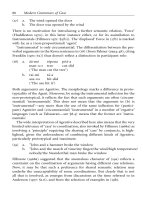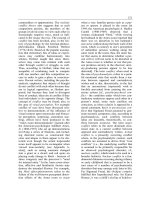learn the Principles of Business Writing PHẦN 3 potx
Bạn đang xem bản rút gọn của tài liệu. Xem và tải ngay bản đầy đủ của tài liệu tại đây (158.95 KB, 10 trang )
have the sequence that feels right to you or makes the most sense to your audience.
What does such an outline look like? In the case of the article for the in-house maga-
zine about the recently finalised restructuring of the Widgets business unit, the outline
could be as follows:
- In response to the 2003 annual results, analysts downgraded stock from buy
to hold. Analysts said Widget cost structure unacceptable compared to com-
petitors. Product pipeline insufficiently filled, problematic after failed launch
of new widget year earlier.
- The Board largely agreed with analysts’ assessments and worked with Widget
leaders to develop a restructuring plan. Company involved unions in all our
countries to ensure smooth implementation later on.
- Plan focused on three areas: labour cost, corporate culture and R&D. These
areas could yield quick results without undermining strategy.
- Labour cost: opted for laying off 1,200 staff, mainly administrative. Closed
down smaller offices and worked with unions to enable early retirement. Main
concern was maintaining R&D capacity and providing sufficient sales support
in growth areas, in order to parry inroads by competitors.
- Corporate culture: after years of lacklustre growth, culture of complacency.
Feeling of responsibility and teamwork weakened, more emphasis on quick
individual gains. Focused on re-engineering the culture while also promoting
entrepreneurship (link to R&D). Introduced new performance-based pay and
competence management.
- R&D: acquired a small research company with Widget-related technology pa-
tents and hired 120 new engineers and scientists. Integrated labs for econo-
mies of scale and closed down two disappointing research projects. R&D staff
bonuses tied to number of products in pipeline and speed at which they move
through (HR link).
- Implementation began early 2004, communicated results of benchmark
study and announced goals and reasons for restructuring. Dedicated imple-
mentation project team with Board support.
21 c a p t u r e . d e l i v e r . e xc e l . f o cus
22 w w w . c a p t u r e d e l i v e r e x c e l . c o m
- Early results indicate cost structure now in line with industry norms and
introduced 5 new projects into the pipeline. Our goal is to introduce one new
project each quarter and bring one project to market each year.
In the case of the fictitious speech for the Minister on an overhaul of the UN,
a possible outline could be:
Introduction
- Ceremonial welcome to guests, congratulate host on organisation and hospi-
tality. Reference to previous conference: dialogue remains key, many challen-
ges remain.
- Today’s meeting at a time of political and economic turmoil: terrorism, reces-
sions, increasing competition for fossil fuels.
- As a result of globalisation, our economies are intertwined: unilateral action
futile, challenges require multilateral approach. This conference seeks way to
achieve this.
Revamping the UN
- Is existing UN able to execute such multilateral approaches? Opinions admit-
tedly divided, but my government believes it is not. Inability of UN to deal
with Somalia, Balkans and Iraq. Also: UN inefficient and corrupt.
- Urgent need for reforms: modernise governance, increase scope of mandate,
organisational and financial streamlining, broaden Security Council member-
ship to reflect modern geopolitical status quo.
- At same time, UN dialogue and action needs to be aligned with other forums
such as WTO. We need to reorganise the UN, but we could explore idea of
synchronising events at WTO and UN.
- Cost of inaction larger than effort to achieve change. UN is vital, but only ef-
fective in a changed format
23 c a p t u r e . d e l i v e r . e xc e l . f o cus
24 w w w . c a p t u r e d e l i v e r e x c e l . c o m
Conclusion
Realise our views are radical, but we really feel the need to make a decision and
move forward. This week’s conference should yield preliminary results. My govern-
ment offers to host next conference.
As both outlines show, the structure of the story is essentially in place. There is already
a logic as to how the different parts connect and what items will be discussed where.
The outline is not particularly compelling, but it does what it’s supposed to do: focus
your thinking and writing. To develop a good outline, you need to connect the dots and
put some meat on the bones.
25 c a p t u r e . d e l i v e r . e xc e l . f o cus
26 w w w . c a p t u r e d e l i v e r e x c e l . c o m
Purpose
You can build on the foundation of focus by writing with your stakeholders’ goals and
interests in mind. But if you want to develop a truly effective story you need to ap-
peal to your readers’ sense of purpose as well. This way you create a text that is both
intellectually sound and emotionally compelling.
Most organisations appear to be dominated by logic, quantitative analysis and deci-
sions based on financial targets, at least if you only look at their use of language. Like
most other organisations, yours will discuss abstract things like ‘synergy’ and ‘high
performance’ or talk about ‘increasing shareholder value’ and ‘exceeding customer
expectations’. This approach has its merits, particularly as a way to facilitate decision-
making and get people to focus their thinking on important organisational issues.
And yet, this is a stale kind of language that most people find difficult to relate to
(imagine what would happen if you asked your partner for more synergy or a cutting-
edge night on the town). This is because a purely rational approach to business writing
doesn’t engage people on the level of their identity. As a result, traditional business
writing fails to achieve full support for the organisation’s mission, vision, strategy and
day-to-day operations.
Your business writing will become more effective when you complement your orga-
nisation’s logical approach with right-brain relational skills. Chiefly, this can be done by
analysing business issues in terms of their purpose and explaining what this means to
people’s lives or the organisation. The principle of meaning is the subject of the next
chapter, this chapter will tackle the principle of purpose in more detail.
Purpose in and of organisations
The notion of purpose may be an odd one within today’s corporate environment, par-
ticularly when a word like ‘goal’ seems more familiar. While both words imply a desired
outcome, they differ in a way that is significant for your ability to write well. Goals
are formulated in response to changes in the competitive environment, are based on
intellectual analyses, and are defined in quantitative or qualitative terms. Examples of
goal-oriented statements are:
the second principle
c a p t u r e . d e l i v e r . e xc e l . p u rpo s e 27
28 w w w . c a p t u r e d e l i v e r e x c e l . c o m
- Next year, we need to increase profitability by 5% if we are to outperform
our competitors.
- In order to expand our presence in the West we need to acquire local
companies.
- This plan aims to attract venture capital to fund the development of a
prototype.
Purpose is derived from a person’s or organisation’s values and beliefs. It is defined in
emotional and relational terms, and remains a constant even when the environment
changes over time. Going against someone’s sense of purpose creates conflict, while
action in line with purpose creates harmony and gives people strength and courage.
Purpose motivates people in a way that goals are unable to, something shown by the
limited effect increased salary has on the performance of people.
Purpose is not a fringe concept but the bedrock upon which the organisation and its
people rest. Successful companies - and people - are purpose-driven, meaning they
have identified their purpose and aligned their goals, actions and relationships with it.
Ideally, a company’s strategy is aligned with its purpose, as are its cultures, processes
and styles of communication. Companies with a strong sense of purpose tend to have
shared values and beliefs.
Unlike goal-oriented language, purposeful language engages people on the level of
their identity. This means that even when discussing hard core business issues like
shareholder value or the supply chain, you can relate to both people’s cognitive and
emotional sides. In other words, you communicate with people in a way that captures
their hearts and minds. Examples of purposeful statements are:
- Let’s make things better. (Philips tagline)
- In my organisation, we believe it is important to help elderly people live
independently as long as possible.
- Good corporate citizenship means balancing the needs of ‘people, planet and
profit’.
A beautiful example of purposeful language is Johnson & Johnson’s Credo. This text,
written in 1943 and updated annually with the participation of all staff, has significant
c a p t u r e . d e l i v e r . e xc e l . p u rpo s e 29
30 w w w . c a p t u r e d e l i v e r e x c e l . c o m









